Jessica Burgner-Kahrs How Can the Characteristics of Continuum Robots Be Optimized for a Specific Medical Application?
Jessica Burgner-Kahrs is Professor at the Leibniz University in Hannover, where she conducts research at the Hannover Centre for Mechatronics leading the Laboratory for Continuum Robotics. Burgner-Kahrs dedicated her doctoral and post-doctoral research to improving the technology used in surgery, e.g. developing a new robotics system for automatic bone cutting or minimally-invasive brain tumor removal. For her innovative research contributions in continuum robotics she was awarded a number of national awards and scholarships, including the Heinz Maier-Leibniz Prize 2015 given to young academics for their outstanding achievements, as well as the Lower Saxony Science Award 2014. Burgner-Kahrs is appointed member of the Young Academy (Junge Akademie), a joint project of the Berlin-Brandenburg Academy of Sciences and Humanities and the German National Academy of Sciences Leopoldina.
Area of Research
Continuum Robotics
since 2015
Associate Professor
University of Hanover (Leibniz Universität Hannover) (more details)
Hanover Center of Mechatronics
2013-2015
Head of Emmy Noether Research Group
University of Hanover (Leibniz Universität Hannover) (more details)
Laboratory for Continuum Robotics
2013
Executive Director
University of Hanover (Leibniz Universität Hannover) (more details)
Center for Mechatronics
2012-2013
Research Fellow
University of Hanover (Leibniz Universität Hannover) (more details)
Center of Mechatronics
2010-2012
Research Associate
Vanderbilt University
Department of Mechanical Engineering
2006-2010
Research Assistant
Karlsruhe Institute of Technology (Karlsruher Institut für Technologie)
Department of Informatics
2002-2006
Student Research Assistant
Karlsruhe Institute of Technology (Karlsruher Institut für Technologie)
Department of Informatics
2010
PhD
Karlsruhe Institute of Technology (Karlsruher Institut für Technologie)
Department of Informatics
2000-2006
Diploma in Computer Science
Karlsruhe Institute of Technology (Karlsruher Institut für Technologie)
Department of Informatics
- Associate Editor, IEEE Transactions on Automation Science and Engineering (since 2016)
- IEEE Transactions on Biomedical Engineering
- IEEE Transactions on Mechatronics, Soft Robotics, Neural Processing Letters
- IEEE Transactions on Robotics
- International Journal of Computer Assisted Radiology and Surgery
- International Journal of Medical Robotics and Computer Assisted Surgery
- ACM - Association for Computing Machinery
- CURAC - German Society for Computer and Robot Assisted Surgery
- DGBMT - German Association of Biomedical Engineering within VDE
- DHV - Germany Association of University Professors and Lecturers
- GI - German Informatics Society
- IEEE RAS - Robotics and Automation Society
- IEEE RAS WiE - Robotics and Automation Society: Women in Engineering
Prizes
- Elected Member of the Junge Akademie, Joint project of the Berlin-Brandenburg Academy of Sciences and Humanities and the German National Academy of Sciences Leopoldina (2016)
- Young Researcher of the Year, Academics Career Portal for Research and Science of ZEIT and the German Association of University Professors and Lecturer (2015)
- Lower Saxony Science Award, Ministry of Science and Culture of Lower Saxony (2015)
- Young Elite - Top 40 under 40, Category: State and Society (2015)
- Category: State and Society, IEEE/RSJ International Conference on Intelligent Robots and Systems (2015)
- Heinz Maier-Leibnitz Prize, German Research Foundation and the German Federal Ministry of Education and Research (2015)
- Finalist Best Application Paper Award, IEEE/RSJ International Conference on Intelligent Robots and Systems (2014)
- Finalist Best Medical Robotics Paper Award, IEEE International Conference on Robotics and Automation (2013)
- Emmy Noether Programme, German Research Foundation (DFG) (2013)
- Best Technical Paper Presentation Award, 10th International Conference on Computer Assisted Orthopedic Surgery (2010)
- Best Poster Presentation Award, runner-up, 6th Annual Meeting of the German Society for Computer and Robot-assisted Surgery (2007)
Fellowships
- Research Fellowship, Support Program: Returning German Scientists from Abroad, German Academic Exchange Service (DAAD) (2012)
- Travel Scholarship, Annual Meeting of the German Society for Computer and Robot-assisted Surgery (2012)
- International Foundation Neurobionics, Robot assisted neursurgical interstitial thermal tumor ablation (RoboNIT) (2016)
- National Institutes of Health (NIH), Debulking from Within: A Steerable Needle for Intracerebral Hemorrhage Aspiration (2014)-2016
- Emmy Noether Research Programme - Continuum Robots for Surgical Systems (2013-2018)
- DAAD Research Fellowship, German Academic Exchange Service Support Program: Returning German Scientists from Abroad (2012-2013)


University of Hanover (Leibniz Universität Hannover)
HannoverIn 1831, founded by the scholar Karl Karmarsch, the “Higher Trade School of Hannover” started with only 64 students. Today there are more than 25,000 students in the natural sciences and engineering, the humanities and social sciences as well as in law and economics. In the future, too, studying, teaching and research are to be enjoyable, and therefore one of the declared goals of Leibniz Universität Hannover is to continually improve the quality of teaching and research. (Source)
Institute
Hanover Center of Mechatronics
The interdisciplinary focal point of mechatronics arises from the close cooperation in the fields of mechanical engineering, electrical engineering and computer science. Mechatronics is needed everywhere where an improvement in the overall functionality is to be achieved through the intelligent combination of these individual disciplines. The efficient concentration of the mechatronics activities at the Leibniz Universität Hannover is achieved through the Hannover Centre for Mechatronics (German: Mechantronik-Zentrum Hannover, MZH) which was established in 1999 and is funded by institutes of the Faculties of Electrical Engineering and Computer Science as well as of Mechanical Engineering. (Source)
Map
The use of continuum robots – robots that are not composed of rigid links and joints but are continuously bending structures – opens up completely new possibilities for surgery: With this tool surgeons can reach locations in the human body which they would not be able to reach with traditional surgical instruments. This enables them to e.g. remove brain tumors in a minimally invasive way. There are a vast number of parameters to be selected when designing these structures, like diameter, tube thickness, and material. JESSICA BURGNER-KAHRS explains that the ideal combination depends not only on the application but also on patient characteristics. In this video, she describes how the research team tackled the challenge of selecting the right robot design by developing an optimization algorithm that makes use of evolutionary concepts from biology. Testing their simulation results in the laboratory proved that the optimization works well, but also revealed a number of open questions.
LT Video Publication DOI: https://doi.org/10.21036/LTPUB10324
Task-specific Design of Tubular Continuum Robots for Surgical Applications
- Jessica Burgner-Kahrs
- Soft Robotics
- Published in 2015









